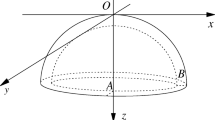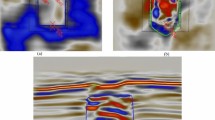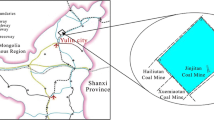Abstract
As the shallow coal seams are gradually being exhausted, mining of the lower group of coal seams in the shallowly buried proximity coal seam group becomes inevitable. Due to geological conditions affecting the upper group coal seams, various coal mining methods have resulted in a significant number of non-sufficient and sufficient collapse mining areas. The presence of water and gas in these mining areas can potentially impact the safe production of the lower group coal seams through inter-layer rock fractures. Therefore, studying the evolution characteristics and formation mechanism of inter-layer rock fractures is of utmost importance. In this paper, we employ theoretical analysis, numerical simulation, and similar simulation methods to investigate the evolution characteristics and formation mechanism of inter-layer rock fractures during the mining of the lower 3–1 coal seam. We specifically focus on the formation of different mining areas in the upper 2–2 coal seam, using the mining of 2–2 and 3–1 coal seams in the Hanjiawan coal mine as our research context. The study results reveal that the inter-layer rock fractures exhibit an overall positive trapezoidal distribution in different mining areas. We quantify the variation in density and width of inter-layer rock fractures in the two mining areas by utilizing the concept of rock damage degree. We analyze the overall damage degree, tensile damage degree, and shear damage degree ratios. The formation of inter-layer rock fractures is primarily influenced by the combined effect of various coal mining methods in both the upper and lower coal seams. The stress changes resulting from mining activities in these seams contribute to the development of transverse separation fractures and longitudinal breaking fractures within the inter-layer rock. The stress changes induced by mining operations in the upper and lower coal seams have been analyzed, and distinct stress regions have been identified. To understand the mechanism of inter-layered rock fracture development in the upper and lower coal seams, a mechanical expansion model of inter-layer rock fractures has been constructed for different stress regions.
Highlights
-
The evolution process and development characteristics of inter-layered rock fractures, as well as their differences when different coal mining methods are employed in the upper coal seam, have been revealed.
-
To determine the influencing factors and development patterns of inter-layered rock fractures under different coal mining methods.
-
Quantitatively comparing and analyzing the damage of inter-layered rock and the percentage of damage degree under different coal mining methods, we found that the damage degree was 61% and 52%, respectively.
-
The study shows that when mining the upper coal seam, the inter-layer rock primarily extends through primary microscopic fractures. On the other hand, when opening the lower coal seam, the main development is observed in macroscopic tension fractures and shear misalignment fractures.
-
Based on the study of the development process of macroscopic fractures and microscopic fractures in the inter-layered rock, the mechanism of fracture development and evolution of the inter-layered rock under different coal mining methods has been determined.


















Similar content being viewed by others
Data availability
The data in the manuscript is true and available.
References
Aben FM, Doan ML, Mitchell TM, Toussaint R, Reuschlé T, Fondriest M, Gratier JP, Renard F (2016) Dynamic fracturing by successive coseismic loadings leads to pulverization in active fault zones. J Geophys Res Solid Earth 121(4):2338–2360
Bai Q, Tu S (2020) Numerical observations of the failure of a laminated and jointed roof and the effective of different support schemes: a case study. Environ Earth Sci 79(10):202
Bai QS, Tu SH, Zhang C, Zhu D (2016) Discrete element modeling of progressive failure in a wide coal roadway from water-rich roofs. Int J Coal Geol 167:215–229
Basista M, Gross D (1998) The sliding crack model of brittle deformation:an internal variable approach. In J Solids Struct 35(5–6):487–509
Cai JJ, Li XJ, Guo LX, Xue HT, Xu BZ (2022) Fracture development and multifield coupling evolution law of soft overburden rock in a medium-thick coal seam mine. Geofluids 2022:1–14
Feng GR, Wang SW, Guo YX, Zhang YJ, Bai JW, Du YL (2021) Optimum position of roadway in the middle residual coal seam between the upper and lower longwall gobs. Energy Sources Part A Recov Util Environ Eff. https://doi.org/10.1080/15567036.2021.1897709
Gong H, Luo Y, Zhou J, Zhao CC, Li XP (2023) Fracture behaviors and damage evolution anisotropy of granite under coupling of multiaxial confinement and dynamic loading. Rock Mech Rock Eng 56:2515–2534
He CC, Lu WY, Zha WH (2020) Evolution mechanism of interconnected vertical fractures in the overburden of longwall coal mining. Geofluids 2020:1–12
Huang QX, Han JB (2019) Study on fracture evolution mechanism of shallow-buried close coal seam mining. J Min Saf Eng 36(04):706–711
Huang QH, He YP, Luo LB, Cao J (2018) Study on the active structure of caved roof and support resistance in shallow buried and ultra-close coal seams mining. J Min Saf Eng 35(03):561–566
Huang QX, Zhao MY, Huang KJ (2019) Study of roof double key strata structure and support resistance of shallow coal seams group mining. J China Univ Min Technol 48(01):71–77+86
Liu HW (2011) Mechanics of materials. Higher Education Press, Beijing
Liu C, Li X, Zhang C, Sun BQ (2021) The spatio-temporal evolution law of overlying rock fractures in an experimental working face (N00 mining method) based on microseismic monitoring technology. Arab J Geosci 14:1373
Lu W, He C, Zhang X (2020) Height of overburden fracture based on key strata theory in longwall face. PLoS ONE 15(1):e0228264
Song Y, Yang SQ, Li KS, Yin PF, Pan PZ (2023) Mechanical behavior and fracture evolution mechanism of composite rock under triaxial compression: insights from three-dimensional DEM modeling. Rock Mech Rock Eng 56:7673–7699
Wang XL (2022) Similar simulation test of overlying rock failure and crack evolution in fully mechanized caving face with compound roof. Geotech Geol Eng 40:73–82
Wang XY, Song XM, Chen CH (2016) The impact study on strata behavior laws of different coal seam spacing in ultra closed coal seams. J Min Saf Eng 33(01):116–121
Wang Y, Tan WH, Liu DQ, Li CH (2019) On anisotropic fracture evolution and energy mechanism during marble failure under uniaxial deformation. Rock Mech Rock Eng 52:3567–3583
Wang Y, Feng WK, Hu RL, Li CH (2021) Fracture evolution and energy characteristics during marble failure under triaxial fatigue cyclic and confining pressure unloading (FC-CPU) conditions. Rock Mech Rock Eng 54:799–818
Xu MT, Xu YL, Jin ZY (2020) Research on support resistance of contiguous coal seam mining under room-and-pillar gob. Coal Sci Technol 48(08):63–69
Yang GS, Wang JS (2018) Overburden structure evolution and pressure law of second mining in close-range coal seam group. J China Coal Soc 43(S2):353–358
Yu MG, Teng F, Chu TX, Chao JK, Li P (2018) Simulation study on the evolution of overlying strata fracture development and air-leaking passage under repeated coal-mining of shallow buried coal seams. J Henan Polytech Univ 37(1):001–007
Zhang Y, Zhang CL, Zhao F (2015) Dynamic evolution rules of mining-induced fractures in different floor area of short-distance coal seams. J China Coal Soc 40(4):786–792
Zhang J, Yang T, Wang B, Zhang Q, Liu D, Reng YB (2017) Prediction analysis of mining roof water-inrush in shallow coal seams with surface valley run off. J Min Saf Eng 34(05):868–875
Zhang ZX, Zhang YB, Xu YX, Zheng Q, Wang ZL, Guo LL (2021) Fracture development and fractal characteristics of overburden rock under repeated mining. Arab J Geosci 14:225
Zhou XP, Zhang YX (2007) Constitutive theory and application of unloading rock mass. Science Press, Beijing, pp 55–72
Zhou XP, Ha QL, Zhang YX (2005) Analysis of local-ization of formation and complete stress-strain relation for mesoscopic heterogeneous brittle rock materials when axial stress is held constant while lateral confinement is reduced. Chin J Rock Mech Eng 24(18):3236–3245
Zhu DF (2018) Study on the bearing characteristics of shallow non-sufficient collapse mining area and the mechanism of disaster caused by repeated mining. Dissertation, China University of Mining and Technology
Zhu DF, Tu SH, Tu HS, Li XY, Liang NG (2018) Analysis of stress propagation mechanism in the interval coal pillars under the gully landform. J Min Saf Eng 35(04):701–707
Zhu WB, Xu JL, Chen Lu, Li Z, Liu WT (2019) Mechanism of disaster induced by dynamic instability of coal pillar group in room-and-pillar mining of shallow and close coal seams. J China Coal Soc 44(2):358–366
Zhu HQ, Fang SH, Huo YJ, Guo JL, Wu Y, Hu LT (2020) Study of the dynamic development law of overburden breakage on mining faces. Sci Rep 10:6555
Funding
Funding was provided by National Outstanding Youth Science Fund Project of National Natural Science Foundation of China (grant nos. 52004200 and 52004204) and National Natural Science Foundation of China (grant no. 51774229).
Author information
Authors and Affiliations
Corresponding author
Additional information
Publisher's Note
Springer Nature remains neutral with regard to jurisdictional claims in published maps and institutional affiliations.
Rights and permissions
Springer Nature or its licensor (e.g. a society or other partner) holds exclusive rights to this article under a publishing agreement with the author(s) or other rightsholder(s); author self-archiving of the accepted manuscript version of this article is solely governed by the terms of such publishing agreement and applicable law.
About this article
Cite this article
Zhang, J., Wu, J., Yang, T. et al. Analysis of Fracture Evolution Characteristics and Formation Mechanism of Inter-Layer Rock Under Different Mining Areas. Rock Mech Rock Eng 57, 3787–3811 (2024). https://doi.org/10.1007/s00603-023-03757-7
Received:
Accepted:
Published:
Issue Date:
DOI: https://doi.org/10.1007/s00603-023-03757-7




